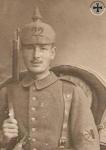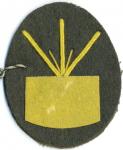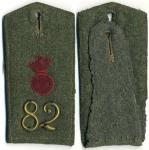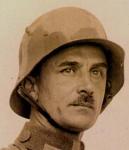-
Posts
2,962 -
Joined
-
Last visited
Content Type
Profiles
Forums
Blogs
Gallery
Events
Store
Everything posted by Chip
-

Searchlight patch
Chip replied to The Prussian's topic in Germany: Imperial Uniforms, Headwear, Insignia & Personal Equipment
-

Searchlight patch
Chip replied to The Prussian's topic in Germany: Imperial Uniforms, Headwear, Insignia & Personal Equipment
Andy, I do have a copy of a photo of this insignia being worn (an image not owned by me). Kraus says that it is known to have been worn by the Saxons, but he is unsure if any other contingents ever used it. My example is a Probe piece, so I assume that it was originally intended for use by units from any state. I do suppose, however, that the Saxons had some Probe pieces that were particular to them, due to their distinctive uniform differences (that is, Saxon cuffs, Kokarden, belt buckles, Helm-Wappen, usw.). I can Skype on Saturday or Sunday. PM me with times you would be available. -

Searchlight patch
Chip replied to The Prussian's topic in Germany: Imperial Uniforms, Headwear, Insignia & Personal Equipment
Andreas, Yes! The one in your picture is unofficial. Here is an official pattern, known to have been worn by Saxon pioneers. Chip -
Kornel did a good job of identification, but the second strap with the "AR" is actually from the Dragoner Regiment König Albert von Sachsen (Ostpreußisches) Nr.10. I have a M1915 example and the cypher and crown are identical. A Feldartillerie regiment would have had a "bursting bomb" on the shoulder strap. The strap with the rounded end is British or Commonwealth from the five button Service Dress (SD) drab uniform. Your best bet for finding out who the field artillery and cavalry units faced is to look at the "Histories of 251 Divisions of the German Army..." (which you can download on-line). The Kraftfahr boards are a general pattern and are not traceable. The FAR 79 spent the entire war with the 41st Division. Starting out on the Eastern Front, it came to the Western Front toward the end of February 1917 and remained in various parts of France and Belgium (Arras, Albert, Flanders, Argonne) for the remainder of the war. Elements of the 10th Dragoons were also in the 41st Division throughout the war. So it looks like those two pieces were grabbed at approximately the same time. Chip
-
The list of makers I posted is, of course, incomplete and new names are being added periodically. I think a better description for "hollow bottom" would be "recessed bottom". These were normally multi-piece constructions where the bottom of the cup was soldered/welded to the body. My example is a 1918 Lamprecht cup in a very dark charcoal gray enamel. Chip
-
A friend has a Saxon Husar Attila (H.R.18) coming that has a tailor's label showing it was the property of one Graf von Schaffgotsch. I don't find him in the Ehren=Rangliste and I don't have any Saxon Rang-Liste. Could someone fill me in on any details about this officer that might be available? Thanks, Chip
-
Here is a list of manufacturers of enameled cups. The list includes maker stamps and the manufacture dates that have been observed. I lifted this list off the German WWI website Feldgrau. I also contributed to it. -A. LAMPRECHT 16, 17 and 17 with recessed bottom, 18 with recessed bottom -AMBOS 16, 17 (big numbers) and 17 (small numbers) -BECHER 16 -B & F 16, 17 -BING 16, 17 and 17 with recessed bottom, 18 and 18 with recessed bottom -E d.L. 16 -E.H. 18 -E. L. S. 17 exists with small and big markings -E. S. B. 17 -ESCHEBACH RADEBERG 1916 and 1917 -FCB FULDA 16, 17 and 18 -GERMANIA 17 and 18 -G.M.u.Cie 18 -G. R. & C° 16,17 and 18 -Hecker & S 16, 17, 18 -Hiby 16 and 18 -Ludwig Hutzler Beierfeld 17 -KLötzer Nachf. Lauter 17, 18 -Klötzer & Jache(?) -M. Böhme 17 -M. & S. 16 -Neust. Em. W. 16 and 17 -R. LOUIS SCHEICHAUER GRIVOR(?) -S.& E. St.L. 16, 17, 18 (with crossed oriental sabers) for maker: "Stahl und Eisen St.Leon" (Baden-Württemberg). -SFD 16 -SILESIA 16, 17 and 18 -S.M.W. 16 -ULLRICH 16,18 -WUPPERMAN 16, 17 and 18
-
Very nice items! I have a few Luger holsters, but have never owned anything but a Reichsrevolver. Would love a nice Luger. I'm curious about your identification of the Bavarian officer's boards. What do you base that on? What color is the underlay? I would have thought that a Train unit would have Arabic numbers and a blue underlay. Chip
-
I've been collecting shoulder insignia since 1962 or so and my ideas about this have changed over the years. When I was starting out and building my collection, I would gladly have broken up a pair of straps to get an example that I was needing. In later years, I came to regret that to some extent, both from a collecting aspect and from a historical one. Today, I would be against breaking up a pair. Pairs take up much more room to display, so even though I have many pairs, I only display singles in my frames. The other halves sit in storage boxes. Another factor is that during the war, the shoulder straps that were collected for intelligence and for the most part, the soldier souvenir straps, were taken as singles. The point being, that the vast majority of shoulder straps that were saved after the war (outside of Germany) were singles. Chip








